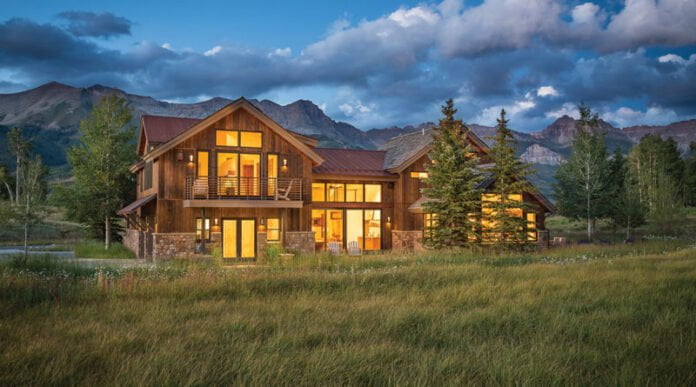Some builders’ clients may take a whole-home approach to sustainability, seeking help designing outdoor areas that are just as environmentally conscious as their homes. Xeriscape landscaping, once thought to be the best way to tackle drought and create a sustainable outdoor space, isn’t the only way that outdoor trade contractors address their clients’ environmental concerns. Colorado landscapers today take a holistic approach, incorporating smart technology, efficient landscaping tools, organic pest control, wildlife habitats and lighting in their sustainable landscape designs.
Tim Flanagan, co-owner of Sustainable Landscapes Colorado (SLC) in Lakewood, promotes a three-phase approach when creating sustainable landscapes for his clients.
First, he improves overall irrigation efficiency and cuts water costs by installing smart controllers with built-in water-saving features, high-efficiency drip systems and improved coverage with more efficient nozzles and spray heads. He then implements sustainable maintenance practices, such as fertigation, the injection of fertilizers into an irrigation system. Finally, he replaces turf areas that are smaller than 8 feet wide, or on more than a 10% slope, with a selection of plants that are easier to maintain and irrigate.
RELATED: Sustainable Building Colorado Style
“There are two different types of landscapes–existing versus new,” says Flanagan, adding that 95% of his company’s business is commercial and 5% residential. “We deal with a lot of existing landscape projects, and the challenge is how we can incorporate sustainability, whether it’s through turf technology, irrigation or a maintenance program, while considering a number of factors–fertilizer, labor and gasoline.”
SLC’s landscape management programs involve mulch mowing to recycle grass clippings and using mulch to protect soils. Flanagan does regular soil testing and uses fertilizer to support biologically active soils. He also incorporates integrated pest management, a process that uses the least toxic pest control only when needed.
Flanagan’s goal is to reduce the amount of money his clients spend on water by between 30% and 50% by using smart irrigation technology, as well as soaker and drip systems to reduce waste, improve maintenance practices and lessen the heavy reliance on turf in the landscapes.
“One myth is that it will be an expensive alternative when it’s not,” he says. “There will be some modifications and investment up front, but the phasing of the program and the ROI from water savings would pay for that relatively quickly.”
Sustainable outdoor equipment
Advances in lithium ion technology have given professionals a new option in battery-powered tools, says Kris Kiser, president and CEO of the Alexandria, Virginia-based Outdoor Power Equipment Institute Inc. (OPEI), an international trade association that represents 100 small engine, utility vehicle and outdoor power equipment manufacturers.
“Power equipment takes a lot of power and torque, so now you’re able to store enough power to run the devices,” says Kiser, adding that studies show they also produce less noise and fewer emissions. Robots and remote-controlled devices also are entering the market in greater numbers, and most are battery-powered.
“The equipment side of the equation continues to get cleaner, quieter and safer,” Kiser says. “There is a product and power source for every need, from gasoline to solar, from battery and electric to propane.”
OPEI’s popular TurfMutt and Living Landscape educational initiatives are designed to better educate people on how living landscapes benefit the environment and have an important role in our natural resources.
“There was a thought that you had to get rid of your yard to prevent climate change, but that’s not true,” Kiser says. “Lawns absorb carbon and produce oxygen. A 50- by 50-foot lot creates enough oxygen for a family of four.”
Lighting it right the first time
When it comes to lighting a commercial business or home, everyone wants sustainability, but it always comes down to the bottom line, says Addie Smith, senior lighting designer for AE Design in Denver.
“For commercial businesses, the most common default for lighting means meeting the code minimum,” says Smith, adding that the code enforces how much energy they can use and how the lights need to be controlled. “For homeowners, they have to choose to value sustainability in the first place, because it can cost more up front to have landscape and exterior lighting on a dimmer or control system.”
Homeowners most often leave their lights on all night. But smart LED lighting is becoming more readily available, allowing consumers to control their light use automatically. This often can be done easily with an app on their smartphone.
“LEDs have been around for 10 years, and they’re the baseline for what everybody uses now, but how you’re controlling that light, consciously or unconsciously, is going to have the biggest effect on energy consumption,” Smith says. “If a homeowner leaves lights on all night, they will be using much more energy than if the lights are turned off at 10 p.m.”
AE Design encourages their clients to be selective with the landscape or building’s features they choose to highlight, rather than illuminating everything equally. Their designers integrate concealed luminaires with minimal glare in the architecture and landscape, using dimmers and timeclock controls.
“We are forgetful people and we have a lot going on in our lives,” Smith says. “Automation takes the thinking out of it. Make the decisions during installation to enhance energy savings, and then you can forget about it or tweak it if it’s not working for you.”
A recent study in Science Advances found that more than 80% of the world, and 99% of European countries and the U.S., live under light-polluted skies. This excessive use of artificial light prevents 80% of North Americans from seeing the Milky Way at night.
“Simple solutions, such as using fewer lights or up-lighting fewer trees can help prevent light pollution,” says Kathleen Menyhart, AE Design project designer. “It’s also important to choose the right lumen output to avoid overlighting, and to aim well-shielded accent lights intentionally to avoid hot spots and glare.”
After all, she adds, “We all love to see stars.”








